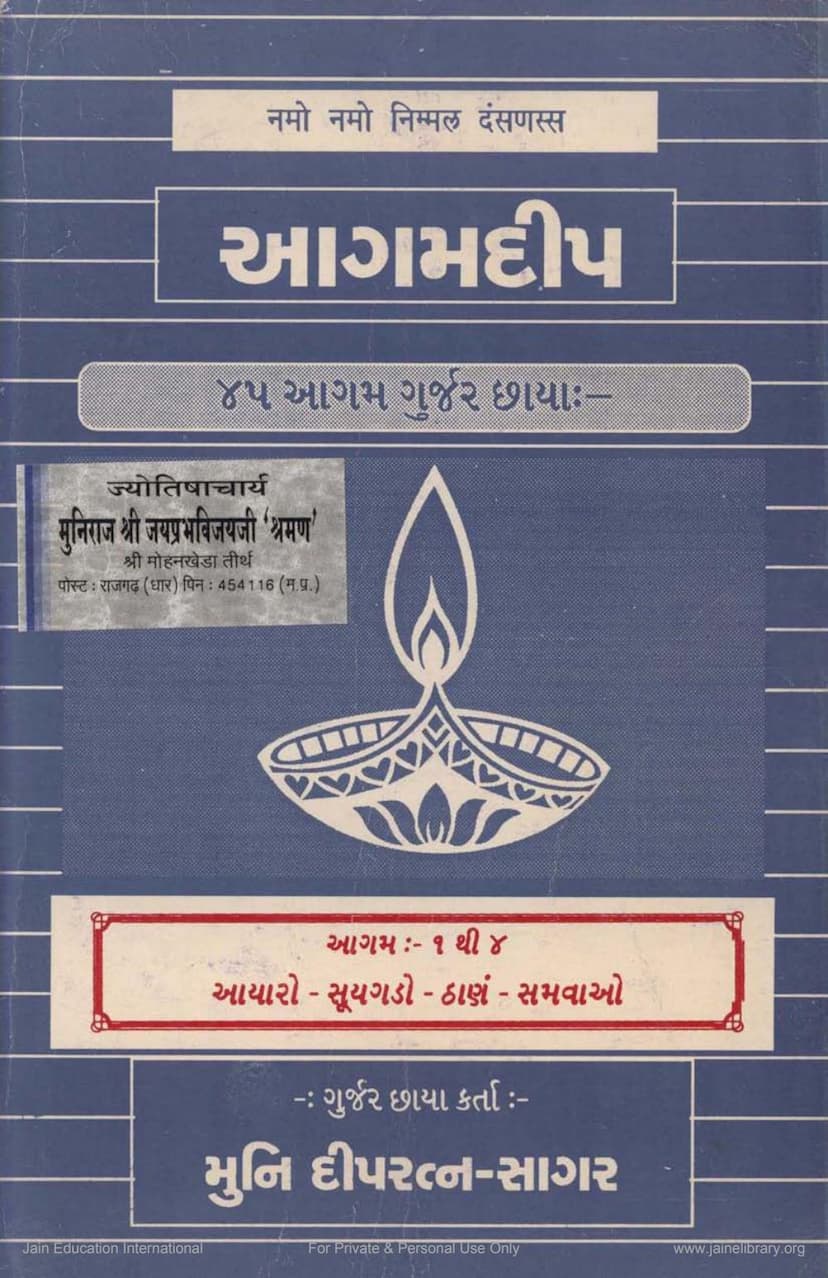Agam Deep 31 Ganivijja Gujarati Anuvaad
Added to library: September 1, 2025

Summary
This document is the Gujarati translation of the Jain Agam text "Ganivijja" (also known as Ganividya or Ganiyijja), as part of the larger "Agam Deep" series. Here's a comprehensive summary of its content based on the provided pages:
Overall Purpose and Context:
- Agam Deep Series: This is volume 31 in the "Agam Deep" series, which aims to provide Gujarati translations and explanations of the Jain Agams. The publisher is Agam Shrut Prakashan.
- Ganivijja (Ganiyijja): The core of this volume is "Ganivijja," identified as the "eighth prakirnak" (miscellaneous text or appendix) within the Agam literature.
- Gujarati Translation and Commentary (Chhaya): The text presents a Gujarati translation and commentary ("Chhaya") of Ganivijja, created by Muni Deepratnasagar.
- Focus on Auspiciousness and Timing: Ganivijja, as presented here, is a compendium of knowledge related to determining auspicious times, astrological influences, and their impact on various activities, particularly for Jain ascetics (monks and nuns) and lay followers.
Key Content Areas Covered in Ganivijja:
The table of contents on page 4 and the detailed explanation on subsequent pages highlight the following key areas discussed in Ganivijja:
-
Balavidhi (Method of Strength/Auspiciousness): The primary theme is the "Balavidhi" or the method of determining the strength and auspiciousness of various factors. The text states it will describe a "uttam navbal vidhi" (excellent nine-fold strength method).
-
Nine Pillars of Strength: The text explicitly lists the nine factors whose strength is analyzed:
- Divas (Day): The strength of days.
- Tithi (Lunar Day): The strength of lunar tithis.
- Nakshatra (Lunar Mansion): The strength of nakshatras.
- Karana (Half-Tithi): The strength of Karanas.
- Graha Divas (Planetary Day): The strength related to planets and days.
- Muhurta (Auspicious Time/Moment): The strength of specific Muhurtas.
- Shakun Bal (Omen Strength): The strength indicated by omens.
- Lagna Bal (Ascendant Strength): The strength of the ascendant.
- Nimitta Bal (Sign/Portent Strength): The strength of signs or portents.
-
Detailed Analysis of Each Factor: The bulk of the text provides specific guidelines on when to perform certain religious and worldly activities based on the strength and nature of these nine factors.
- Days: Discussion on the strength of days, with specific days being stronger or weaker for certain actions.
- Tithis: Categorization of tithis (Nanda, Bhadra, Vijaya, Tuchchha, Purna) and their suitability for activities like initiation (diksha), vows (vrat), and fasting (anashan).
- Nakshatras: Identification of auspicious nakshatras for travel (gamana), staying (sthana), initiation, study (vidyarambha), and other religious practices. It also details "inauspicious" or "weak" nakshatras like Sandhyagat, Ravigat, Vidhghat, Sangrah, Vilambi, Rahugat, and Grahabhinna, explaining the negative consequences associated with them.
- Karanas: Mention of various Karanas and their suitability for initiation, vows, and fasting.
- Muhurtas: Discussion on Muhurtas based on shadow measurements (angul chhaya) and their significance for various activities.
- Omens (Shakuna): Guidance on performing diksha based on omens (male, female, neuter, mixed) and interpreting other natural phenomena like animal sounds, bird calls, and celestial events for religious and worldly actions.
- Lagnas (Ascendants): The suitability of different types of ascendants (moving, fixed, dual, directional) for initiation, vows, and other practices.
- Planets: The influence of auspicious (Saumya) and inauspicious (Krura) planets in the ascendant for various religious activities.
- Nimitta (Portents/Signs): The importance and interpretation of portents, distinguishing between "sudarshana" (well-seen) and "durdarshana" (ill-seen) portents, and their impact on behavior and religious actions. It emphasizes that good portents are crucial for auspicious beginnings.
-
Specific Jain Practices Discussed: The text frequently mentions specific Jain practices for which the timing and auspiciousness are being determined, including:
- Diksha (Initiation): For monks and nuns.
- Vrata-upasthapana (Observing Vows): For lay followers.
- Vidyarambha (Beginning of Studies):
- Ganis and Vachakas: Procedures related to appointing or recognizing learned monks.
- Tapa-krama (Fasting and Austerities):
- Acharya's role: Directing and performing certain rituals.
- Anasana (Fasting unto death):
Publisher and Supporters:
- Agam Shrut Prakashan: The publisher of the Agam Deep series.
- Key Financial Supporters (Dravya Sahayaks): The publication is supported by various individuals and trusts, with Smt. Naynaben Rameshchandra Shah and her family being the primary donors for the entire Agam Deep series and also for this volume. Other donors are acknowledged for specific Agams or parts of the series.
- Printing and Composition: Navprabhat Printing Press (Ahmedabad) and Shri Graphics (Ahmedabad) are credited for printing and composition, respectively.
Structure of the "Agam Deep" Series:
- The catalog link (jainqq.org) and the page numbers indicate that "Agam Deep" is a multi-volume series dedicated to translating and explaining the vast corpus of Jain Agams.
- Page 8 and 10 provide a list of various Agam texts (Angas, Upangas, Prakirnakas, Mulasutras, Chhedasutras, etc.) that are being covered or have been covered in the "Agam Deep" series, often mentioning the corresponding "Agam Deep" volume number for each translated text. "Ganivijja" is identified as "Agam Deep 31."
In essence, this volume of Agam Deep provides a detailed, practical guide based on Jain principles of astrology and auspicious timing, helping followers choose the most suitable moments for important religious and spiritual activities, as elaborated in the ancient Jain text of Ganivijja.